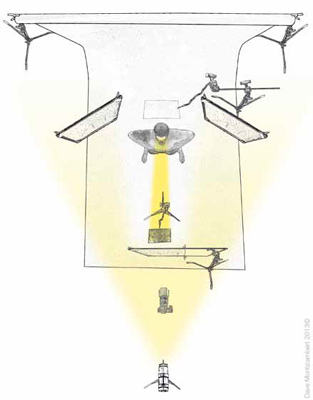articles/Lighting/catchlightsbedtimestory-page1
A Catch Light's Bedtime Story - part 1 of 1 2
by Dave Montizambert Published 01/02/2013

In the early days of my photo career, cinema was a great inspiration. In particular I loved the lighting created in the B&W classics of the 1940s and 1950s (and for those of you who cannot remember that far back, look to George Clooney's 2005 film Good Night and Good Luck). To make up for the bad script writing and for the corny lines that were used, incredible lighting was created on the actors, it was often very dramatic and very contrasty. The night scenes were the most dramatic with their bright, heavy backlighting, dark underexposed flesh-tones, and bright beautiful catch lights in the eyes. In trying to duplicate this it was the catch lights that I couldn't get the hang of - I couldn't figure out how to underexpose the fronts of people to simulate night time, while maintaining brilliant eyes?
It wasn't until a few years later, when I was learning about specular highlight control while studying with my lighting mentor Dean Collins, that I figured it out - you can independently control the brightness of specular highlights (in our case, catch lights) from the brightness of the subject's actual tone. If you look to my last article, Big Red, in the December/January issue of Professional Imagemaker, you will see that I controlled the brightness of the reflection of the light source (a specular highlight) on the pepper independently from the pepper's red tone, by altering the distance of the main-light. I was able to reduce the brightness of the specular highlight on the red pepper by simply moving the light source in closer and adjusting exposure.
Changing the distance of the light source will affect the brightness of all specular highlights caused by that light. The question is, to increase the brightness of the catch light in the subject's eyes relative to the brightness of their flesh, would you move the light source further away or closer? If a source, lighting the front of your subject, were moved away to double the distance, the visual size of that light to the subject would now appear ¼ of its original size. This alters the catch light - it appears smaller, yet it appears to have the same brightness. How is it possible that the catch light can shrink to cover ¼ of the area of the origin area on the eye and still be the same brightness? Moving the light source away from the subject, let's say from 5 feet to 10 feet, will cause ¼ of the volume of light to fall on the subject. The catch light still appears to be the same brightness because the amount of light energy striking it decreased at the same rate that the catch light decreased in size. A quarter less energy spread over a quarter less area equals same intensity - they cancel each other out. If you are to keep the original exposure of the face, the exposure will need to be adjusted. By turning up the power of the strobe head by two f-stops, or by selecting a two-stop larger aperture opening, the flesh-tone brightness will be restored. But what will this adjustment do to the brightness of the catch light? It will appear brighter. To recap, the flesh-tone becomes darker while the catch lights stay the same brightness, the catch light stays the same brightness because it becomes smaller at the same rate that it receives less light energy (the catch light dropped to ¼ of its former size at the same time that it received ¼ less light) - the decrease in size cancels out the decrease in energy allowing the catch light to keep the same brightness. Since the flesh-tone receives less light it appears darker, but to keep the same brightness as it had at the closer light distance, it is necessary to re-meter. The meter provides a reading, instructing us to increase the exposure. This new exposure brings the brightness of the flesh-tone back up to the original brightness. It also increases the brightness of the catch light. In the end, the catch light appears more intense and smaller, while the flesh-tone appears as though nothing has happened. Increasing source distance from subject increases specular contrast.
You are currently on page 1 Contact Dave Montizambert
1st Published 01/02/2013
last update 09/12/2022 14:52:20
More Lighting Articles
There are 17 days to get ready for The Society of Photographers Convention and Trade Show at The Novotel London West, Hammersmith ...
which starts on Wednesday 14th January 2026





